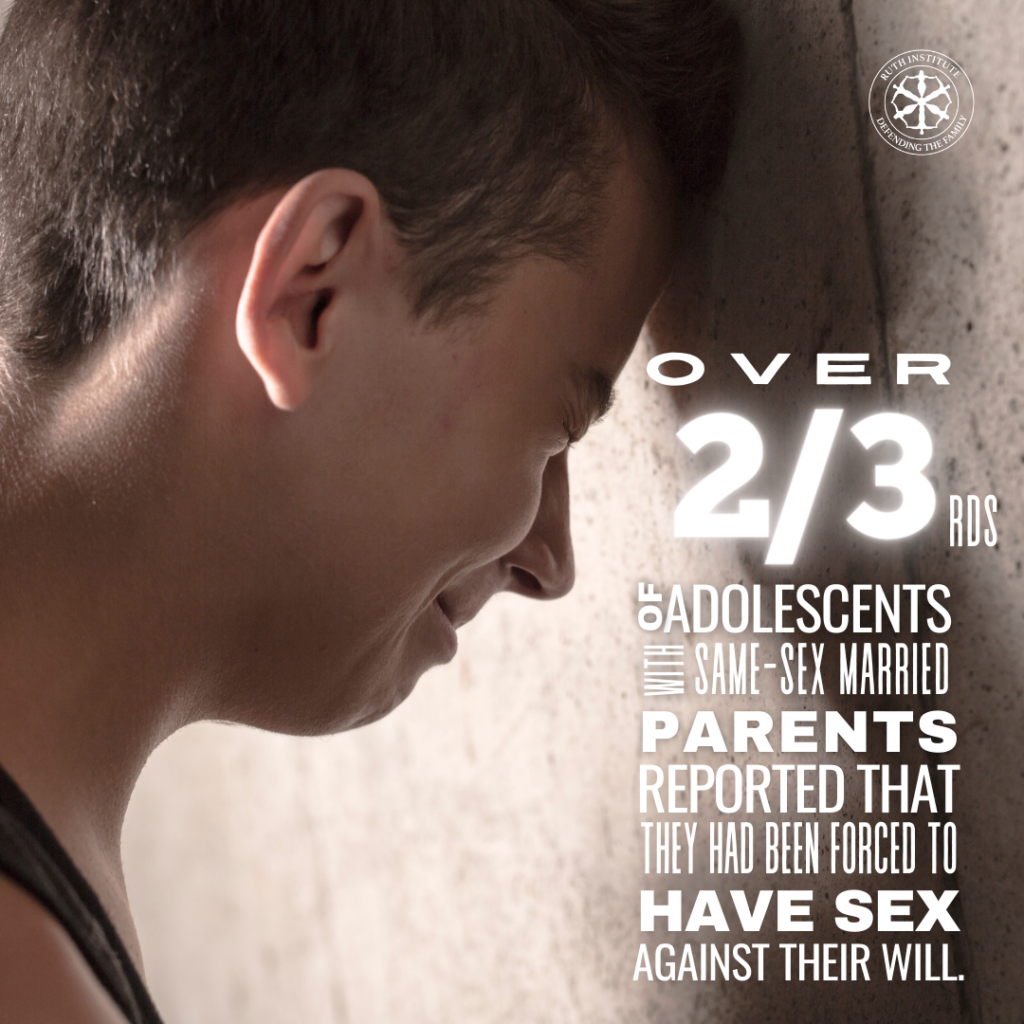
Originally Published at ThemBeforeUs.com
There have been several studies done in an attempt to show “no difference” in child outcomes between same-sex and opposite-sex parenting. Studies commonly cited in support of same-sex parenting are Reczek’s, “Family Structure and Child Health; Does the Sex Composition of Parents Matter?,” and Wainright, Russell, and Patterson’s study on adolescents with same-sex parents. Dr. Donald Paul Sullins, sociologist and researcher, found flaws in the data presented by the research of both Reczek and Wainright, Russell, and Patterson.
Children in same-sex families are at higher risk of emotional and behavioral difficulties
The Reczek study, which used data from the National Health Interview Survey, presented an analyses of health measures on children with parents in four types of unions, including same-sex married, same-sex cohabiting, different-sex married, and different-sex cohabiting. The study claimed that child outcomes were improved for children with married same-sex parents just as they are for those having married opposite-sex parents: “children in cohabiting households have poorer health outcomes than children in married households regardless of the sex composition of their parents. Children in same-sex and different-sex married households are relatively similar to each other on health outcomes, as are children in same-sex and different-sex cohabiting households.” The study reported the odds ratios for child emotional difficulties comparing cohabiting with married parents went from 1.7 to 1.0 with OS parents and from 3.0 to 1.0 with SS parents.
However, as Dr. Sullins discovered in his 2017 study, Reczek made two disabling errors, and a third that obscured the evidence. The first error was that 42% of the alleged “same-sex married” partners in their sample were actually misclassified opposite-sex married partners. This classification error had been reported by the NCHS (National Center for Health Statistics, the CDC agency that produces the NHIS) but was ignored by the authors of this study. After Sullins corrected this error, he found that child emotional difficulties odds ratios comparing cohabiting with married SS parents went from 3.0 to 2.9. In other words, married SS parents made no difference.
The second error was that the researchers controlled for “biological parentage” (whether the child is living with 2, 1, or 0 of his/her biological parents), which improperly removes most differences between same-sex parented and opposite-sex parented children by design, since same-sex parents can never be joint biological parents. As Sullins states, “Controlling for biological parentage when analyzing differences due to same-sex or different-sex parent partnership is like controlling for skin color when analyzing black-white race differences, or the presence of a Y chromosome when analyzing sex differences. The ‘control’ in these cases acts as a suppressor variable masking most or all differences in the variable of interest.”
The third error was that the authors categorized the measure of emotional difficulties in a way that understated and obscured the important differences between groups, rejecting the standard way the CDC had developed and validated for the use of this measure (without acknowledging that they had done so). Dr. Sullins restored the standard CDC usage of the measure, and found that child emotional difficulties odds ratios comparing cohabiting with married SS parents went from 3.7 to 5.6. In other words, the children did worse with married rather than cohabiting SS parents.
Sullins had previously tested in 2014 whether small non-random sample findings from Reczek that children with same-sex parents suffer no disadvantage could be replicated in a large population sample. Using a sample of 207,007 children, including 512 with same-sex parents from the U.S. National Health Interview Survey, he found a significant difference in emotional problems among same-sex and opposite-sex parented children.
The likelihood of struggling with ADHD, learning and intellectual disabilities, and mental health issues are higher among same-sex parented children
Sullins reports, “…on the Strengths and Difficulties Questionnaire (SDQ), children in same-sex families were over twice (2.1 times) as likely, at 9.3%, to have emotional or behavioral difficulties than were children in opposite-sex families, at 4.4%. Likewise, same-sex parents or informants reported that their children experienced ‘definite’ or ‘severe’ emotional problems over twice (2.3 times) as often as did opposite-sex parents or informants. For the most restrictive test, which is both high SDQ and directly reported serious emotional problems, the proportion of children with emotional difficulties in same-sex families drops to only 6.3%, but the comparative proportion in opposite-sex families drops even more, to 2.1%, with the result that the risk ratio for same-sex families is even higher (2.9)….of children whose parent or informant reported both a high SDQ score and serious emotional problems, 58% had been diagnosed with ADHD, 49% had a learning disability and 7% had an intellectual disability; 72% had one or more of these three.”
Children of same-sex parents experienced “definite” or “severe” emotional problems at a rate of 14.9% versus 5.5%, were diagnosed with Attention-deficit/hyperactivity disorder (ADHD) at a rate of 15.5% versus 7.1%, struggled with learning disabilities at a rate of 14.1% versus 8%, and received special education and mental health services at a rate of 17.8% versus 10.4%.
Wainright, Russell, and Patterson
Sullins replicated the WRP study using the National Longitudinal Survey of Adolescent Health, and found that “…re-examination of the same-sex parent sample finds that 27 of the 44 cases are misidentified heterosexual parents; they did not adjust for survey design and clustering; and ignored 99 percent of the baseline by using a small matched sample for comparison.”
According to Sullins, “…WRP compared boys and girls separately within each family type, despite having already matching the two comparison groups on sex. This analytical choice responds to other interests in their study, but it also reduces each of the already-small family type groups by about half. Second, and more seriously, instead of comparing the children with same-sex parents with the full remaining sample of approximately 20,000 children, WRP compared them to another group of 44 children matched to the children with same-sex parents on a number of demographic characteristics. A matched comparison like this is an acceptable way to control for differences in age, sex, parent education and income, etc., but in this case, since the groups are so small to begin with, doing so renders it needlessly more difficult to show differences between the groups….Instead of comparing a small group with large standard errors to a large group with correspondingly small standard errors, WRP compared two small groups, both of which have large standard errors. Essentially, WRP ignored 99% of the baseline, nullifying the power of the large Add Health sample.”
During the National Longitudal Survey on Adolescent Health interviews, adolescents were asked to identify their relationship to and the sex of the members in their households. There were 44 cases found which showed the female parent being in a lesbian marriage or marriage-like relationship. The WRP study used this information and added a criteria check that proved that of the 44 cases, there was no male figure reported as residing in the household, and identified 18 cases. WRP then rejected this criterion, as it eliminated adolescents from divorced families who had parents currently involved in same-sex relationships. However, as Sullins states, “The Add Health interview only asked responding adolescents about persons ‘who live in your household.’…If the adolescent reported the presence of a father or father figure in this series of questions, this could not have been a father in another household, as would be the case in a joint custody situation.” Of the 44 cases, half of them reported their biological father living in the home, and another five included step, adoptive, or foster fathers. These 27 families are obviously not lesbian families, but more likely miscoded opposite-sex parents, meaning that there is an issue with inconsistent sex designation. There were 17 cases consistently identified as lesbian households, but WRP improperly identified another 18 cases.
Child depressive symptoms, negative interpersonal symptoms, and rates of anxiety, daily fearfulness, and crying are higher for those with married same-sex parents
Once these category errors were resolved, Sullins found that child depressive symptoms rise from 50% to 88% when comparing unmarried to married same-sex parents. Depressive symptoms for children with opposite-sex married parents are lower than average (47.2%), rise to 56% with unmarried opposite-sex parents, and rise further to 87.8% with married same-sex parents. Children with unmarried same-sex parents are happier than children with unmarried opposite-sex parents, but those with married opposite-sex parents are much happier than those with married same-sex parents
Children with married same-sex parents are over twice as likely to have above-average negative interpersonal symptoms (22.7%) than those with unmarried same-sex parents (11.5%), though overall, children with same-sex parents have lower negative interpersonal symptoms than children with opposite-sex parents, showing that they are not subjected any more to social rejection than opposite-sex parented children. Anxiety is also higher for children who have both married and unmarried same-sex parents, though surprisingly higher with married parents. The number of children reporting daily fearfulness or crying is higher for children with unmarried opposite (4.4%) and same-sex parents (5.4%), but over ten times higher for children with married same-sex parents (32.4%).
Higher rates of familial transitions = less stability and higher risk of sexual abuse
Almost every child with same-sex parents (83-88%) reported having experienced at least one familial transition compared to 45% of children with unmarried opposite-sex parents, and 19% of children with married opposite-sex parents. The number of children who had experienced at least one transition from one set of parents to another was at least four times higher for unmarried and married same sex parents than for those raised by opposite-sex parents. Further, 10% to 12% of children with opposite-sex parents reported having been forced (or forcing someone) to have sexual intercourse. For those with same-sex unmarried parents, this percentage doubles, and almost triples with same-sex married parents.
Children with married same-sex parents are at higher risk of being forced to have sex or give/ receive sexual touch by a parent or caregiver
Over two thirds of adolescents with same-sex married parents reported that they had been forced to have sex against their will at one point. The responses from those with same-sex married parents were all females reporting being forced, not forcing someone else, to have sex. When asked whether the adolescent had ever been forced to give or receive sexual touch or to have sex by a parent or caregiver, 38% of those with married same-sex parents responded “yes,” as compared to 0-7% of those in the other three categories. This aligns with other data which confirms that children in households with unrelated adults (of which there will always be one in same-sex homes) are at higher risk of neglect and abuse.
Dr. Sullins’ findings are the very reason Them Before Us advocates for marriages that unite the two persons to whom children have a natural right – their mothers and fathers. The natural right to be raised by their biological mothers and fathers grants them safety, identity, and the complementary gender balance which maximizes their psychological and physical development.
